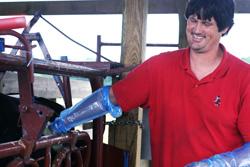The handful of bovines that roam the research pastures on Lake Wheeler and Reedy Creek roads give the term “holy cow” a new meaning.
They are fistulated cattle and have an open hole a little bigger than a jar lid in their side. The hole is covered with a cannula, a small plastic device that provides researchers direct access to their organs.Researchers can reach into this window to remove rumen fluid directly from the stomach.
“The rumen is the most intricate microbial environment on earth,” animal science professor Gerald Huntington said. “That means microbiologists are very interested in what goes on in there.”
And what goes on is beneficial for both research and keeping a herd of cattle healthy.
“They’re the prized possession of our herd and of any herd in the United States,” Vivek Fellner, an associate professor of animal science, said. “When you fistulate an animal and give them so much personal attention that you realize they know they’re the queen of the herd. They let you know, and they let the herd know.”
Holy Jo, the fistulated cow that lives on the Dairy Education Unit off Lake Wheeler Road, is not exempt from this bovine hierarchy. She gets more attention from management each day, mainly because the unit is using her for research.
The research that takes place involves taking partially digested cud from her rumen and fills glass fermenters – which mimic the inner-workings of a cow’s stomach, but can be adjusted to mimic the stomach of a human. He incubates the rumen “for many days,” and uses the result to study anti-cancer components that are found naturally in cattle.
But fistulated cattle can also help their herd by screening potential feeds and donating rumen to sick cattle.
“Typically, a sick cow has compromised her microbial population,” Fellner said. “The rumen in the sick cow is off balance.”
Farm owners and researchers can take the fistulated cow’s rumen, which has a “good mix of bacteria,” Fellner said, and drench, or pump through a tube, it into a sick cow or steer’s stomach. This process inoculates sick cattle, and Fellner said they get better soon after drenching.
Cattle are members of the “cud-chewing” animal group called ruminants, which includes giraffes, sheep, goats and gazelles. Because they eat grass and leaves, which is made up mostly of the indigestible compound cellulose, ruminants employ an arsenal of tiny organisms to live in their stomachs and break down compounds.
These compounds are different species of bacteria, fungi, protozoa and yeast, all living inside the cow breaking down what the cow eats. They have a symbiotic relationship with the cow, in which the cow gives the organisms plant material to eat and the organisms turn it into something the cow can digest.
There is more to a cattle herd than just cows.
“Cow and cattle are not synonyms,” Huntington said. This is an important distinction in the cattle world. “Cattle is the general term, a cow is an adult female, a heifer is a young female that hasn’t had a calf, a bull is either a young or adult male, and a steer is a castrated male,” he said.
“So, impress your cowboy friend with your know-how, and don’t call anything that lives in the pasture a ‘cow’.”
Cow or steer, everybody in the herd uses symbionts to help them eat.
According to Tyler Carmack, veterinarian and alumna, intentional holes in animals date back almost 200 years.
“A Canadian man had a stomach wound that wouldn’t heal completely, and it puzzled doctors that he wasn’t dying from it,” she said.
After a while, the doctors realized they could see the inner workings of his digestive system through the hole.
“Fistulating farm animals for research purposes came from this observation,” Carmack said.
N.C. State’s fistulated cows aren’t suffering.
“If anything, fistulated cattle live longer because of their valuable contributions,” Huntington said. “The surgical procedure does not cause permanent damage or pain to the cattle.”
The average lifespan of a cow or steer is about two to three years, according to Anthony Chestnut, the research operations manager for the Dairy Education Unit. After that time cattle start to be less productive and, from a business standpoint, it is less costly to send them to market than to keep feeding each cow or steer 80 pounds of feed a day.
But Holy Jo, Fellner said, is immortal. She is not used for milking purposes, and she is not standing on concrete all day. She will live her life until she dies of natural causes. Similar cattle, Fellner said, have lived to be 20 years old.
“She’s spoiled,” Chestnut said. “She’s like a big puppy dog.”
Despite their valuable contributions to bovine and global communities, as well as to the scientific world, fistulated cows are not immune to cattle puns. Just ask architecture graduate student Megan Kight and she will joke, “Holy cow! Steering research in the right direction? That’s udderly neat.”
Features Editor Alison Harman contributed to this report.








